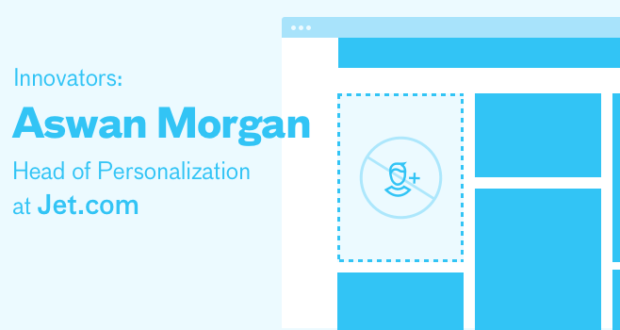{This post first appeared on the Clearhead.me blog}
There are a lot of people, brands and technology companies out in the market talking about personalization. More often than not they want you to buy something to enable “next generation” personalization. At Clearhead, we believe that personalization needs to be powered by exceptional people, process, culture and technology and focused on the customers needs. That’s why what our friend Aswan has to say about personalization in his interview is so powerful. We love the line that “exceptional personalization doesn’t live inside widgets…and can’t be tacked onto a digital experience.” Read on to find out more.
How do you define personalization at your company when it comes to the online experience?
Aswan: At Jet.com, we don’t view personalization as a singular thing you can point to. Exceptional personalization doesn’t live inside discrete widgets and it isn’t something that can be tacked onto a digital experience. Personalization must be in the DNA of the end-to-end customer journey; it’s a core business principle that channels our obsession with helping the customer achieve their goals through smartly-tailored experiences that feel authentic, human and unique.
Its manifestation should be ubiquitous, operating behind-the-scenes and in obvious touches throughout the customer journey that are based on a holistic view of the shopper—a confluence of diverse behavioral, demographic, and psychographic inputs. To de-abstract this a bit, it’s not just about figuring out the next logical product to show the customer. We take pride in our world-class customer service, so how can we use personalization to optimize how customers are paired with service reps? We strive to create a human connection with our customers and are exploring personalization as a means for transforming retail-speak (taxonomy, SKUs, and technical attributes) into pragmatic terms that reflect how the customer actually thinks about and shops for products. There’s a myriad of problems demanding to be solved.
Now, personalization for Jet.com doesn’t mean unleashing a firehose of deterministic algorithms on our customers such that they drown inside a filter bubble. We believe personalization must lead to serendipitous moments and yield to a human touch from things like curation and product authority. It’s our aim to achieve an optimal balance in the most transparent way possible.
What problem does personalization solve for your customer?
Aswan: We have a very sophisticated set of shoppers that come to Jet.com for very different reasons. Without personalization, experiences fall flat and customers can be left underserved as they unnecessarily navigate hurdles to try to meet their shopping goals. Personalization is about respecting the shopper; it’s about extracting the friction and finally letting them have retail their way, effortless and delightful.
When it comes to getting the right data for personalization to work, how are you approaching that? What departments are involved?
Aswan: Personalization is only as good as the data you feed into it. Truly understanding the shopper and anticipating their broader shopping needs involves listening and learning whenever they interact with our brand—knowing when to explicitly ask for information to guide their experience versus learning from customer action.
It’s our job to make sense of this broad set of implicit and explicit customer inputs and get to the core of the shopper’s interests, intent, and values. For example, what does a shopper’s location inform us about the kinds of retail services they need? If they live in a 4th floor studio of a Manhattan walkup, what does that demand with respect to the portability of our packaging, the predictability of our delivery methods, and even the slices of our catalog that we show them?
The “right data” also includes the quantitative and qualitative outputs of these personalized experiences, which we use as feedback to iterate and optimize. This involves AB and multivariate testing to understand what’s happening and user research (customer interviews, watching people shop, etc.) to get our arms around the “why.”
At Jet.com, we’re putting initiatives in place to elevate our awareness of the shopper, respond with experiences that solve their needs in a re-humanized, rewardingly personal way, and learn how to make it better for the next time they engage.
We’re democratizing personalization in a deeply-collaborative, cross-team effort so that it’s an arrow in everyone’s quiver and not just siloed to one specific team.
What are the channels where you have experimented with personalization? What is the order of priority and why?
Aswan: We follow the friction; we relentlessly seek out the biggest sources of customer pain and let that guide our prioritization. While desktop, mobile web and native are key areas of focus for us, we’re experimenting with how we further use data and insights to optimize interactions throughout the customer journey, traditionally thought to be outside the bounds of personalization. As the retail industry as a whole continues to make strides in creating personalized experiences for shoppers, strategic, creative and divergent thinking in how customer problems are solved will be even more critical.
At Clearhead, we too believe personalization should be a part of the end-to-end customer journey. Interested in how the Clearhead Accelerator practice can help your team on your personalization journey? Reach out to learn more.
 501derful.org
501derful.org




